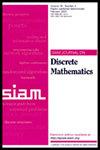图形的边界和障碍数计算
IF 0.9
3区 数学
Q2 MATHEMATICS
引用次数: 0
摘要
SIAM 离散数学杂志》,第 38 卷第 2 期,第 1537-1565 页,2024 年 6 月。 摘要。一个图[math]的障碍表示由一组成对不相交的简单连接封闭区域和[math]顶点到点的一一映射组成,当且仅当连接两个对应点的线段不与任何障碍相交时,两个顶点在[math]中相邻。图形的障碍数是图形在平面上的障碍表示中,所有障碍都是简单多边形的最小障碍数。已知每个[math]-顶点图的障碍数为[math] [M. Balko, J. Cibibi, J. Cibibi, J. M.Balko, J. Cibulka, and P. Valtr, Discrete Comput.Geom., 59 (2018),第 143-164 页],并且存在障碍数为[math]的[math]-顶点图[V. Dujmović and P. Morin, Electron. J. Combin., 22 (2015),3.1]。对于简单多边形,我们将这一下界改进为[math];对于凸多边形,我们将其改进为[math]。为了得到这些更强的下界,我们改进了对障碍数有界的[math]顶点图数量的已知估计,解决了杜伊莫维奇和莫林的一个猜想。我们还证明了,如果把某个[数学]顶点图的绘制作为输入的一部分,那么对于某些绘制来说,需要[数学]障碍才能把它们变成图的障碍表示。我们的边界在一些情况下是渐近紧密的。我们用两个复杂度结果来补充这些组合界限。首先,我们证明了计算一个图[math]的障碍数在[math]的顶点覆盖数中是固定参数可控的。其次,我们证明,给定一个图 [math] 和一个简单多边形 [math],用 [math] 作为唯一的障碍来决定 [math] 是否允许障碍表示是 NP 难的。本文章由计算机程序翻译,如有差异,请以英文原文为准。
Bounding and Computing Obstacle Numbers of Graphs
SIAM Journal on Discrete Mathematics, Volume 38, Issue 2, Page 1537-1565, June 2024.
Abstract. An obstacle representation of a graph [math] consists of a set of pairwise disjoint simply connected closed regions and a one-to-one mapping of the vertices of [math] to points such that two vertices are adjacent in [math] if and only if the line segment connecting the two corresponding points does not intersect any obstacle. The obstacle number of a graph is the smallest number of obstacles in an obstacle representation of the graph in the plane such that all obstacles are simple polygons. It is known that the obstacle number of each [math]-vertex graph is [math] [M. Balko, J. Cibulka, and P. Valtr, Discrete Comput. Geom., 59 (2018), pp. 143–164] and that there are [math]-vertex graphs whose obstacle number is [math] [V. Dujmović and P. Morin, Electron. J. Combin., 22 (2015), 3.1]. We improve this lower bound to [math] for simple polygons and to [math] for convex polygons. To obtain these stronger bounds, we improve known estimates on the number of [math]-vertex graphs with bounded obstacle number, solving a conjecture by Dujmović and Morin. We also show that if the drawing of some [math]-vertex graph is given as part of the input, then for some drawings [math] obstacles are required to turn them into an obstacle representation of the graph. Our bounds are asymptotically tight in several instances. We complement these combinatorial bounds by two complexity results. First, we show that computing the obstacle number of a graph [math] is fixed-parameter tractable in the vertex cover number of [math]. Second, we show that, given a graph [math] and a simple polygon [math], it is NP-hard to decide whether [math] admits an obstacle representation using [math] as the only obstacle.
Abstract. An obstacle representation of a graph [math] consists of a set of pairwise disjoint simply connected closed regions and a one-to-one mapping of the vertices of [math] to points such that two vertices are adjacent in [math] if and only if the line segment connecting the two corresponding points does not intersect any obstacle. The obstacle number of a graph is the smallest number of obstacles in an obstacle representation of the graph in the plane such that all obstacles are simple polygons. It is known that the obstacle number of each [math]-vertex graph is [math] [M. Balko, J. Cibulka, and P. Valtr, Discrete Comput. Geom., 59 (2018), pp. 143–164] and that there are [math]-vertex graphs whose obstacle number is [math] [V. Dujmović and P. Morin, Electron. J. Combin., 22 (2015), 3.1]. We improve this lower bound to [math] for simple polygons and to [math] for convex polygons. To obtain these stronger bounds, we improve known estimates on the number of [math]-vertex graphs with bounded obstacle number, solving a conjecture by Dujmović and Morin. We also show that if the drawing of some [math]-vertex graph is given as part of the input, then for some drawings [math] obstacles are required to turn them into an obstacle representation of the graph. Our bounds are asymptotically tight in several instances. We complement these combinatorial bounds by two complexity results. First, we show that computing the obstacle number of a graph [math] is fixed-parameter tractable in the vertex cover number of [math]. Second, we show that, given a graph [math] and a simple polygon [math], it is NP-hard to decide whether [math] admits an obstacle representation using [math] as the only obstacle.
求助全文
通过发布文献求助,成功后即可免费获取论文全文。
去求助
来源期刊
CiteScore
1.90
自引率
0.00%
发文量
124
审稿时长
4-8 weeks
期刊介绍:
SIAM Journal on Discrete Mathematics (SIDMA) publishes research papers of exceptional quality in pure and applied discrete mathematics, broadly interpreted. The journal''s focus is primarily theoretical rather than empirical, but the editors welcome papers that evolve from or have potential application to real-world problems. Submissions must be clearly written and make a significant contribution.
Topics include but are not limited to:
properties of and extremal problems for discrete structures
combinatorial optimization, including approximation algorithms
algebraic and enumerative combinatorics
coding and information theory
additive, analytic combinatorics and number theory
combinatorial matrix theory and spectral graph theory
design and analysis of algorithms for discrete structures
discrete problems in computational complexity
discrete and computational geometry
discrete methods in computational biology, and bioinformatics
probabilistic methods and randomized algorithms.

 求助内容:
求助内容: 应助结果提醒方式:
应助结果提醒方式:


